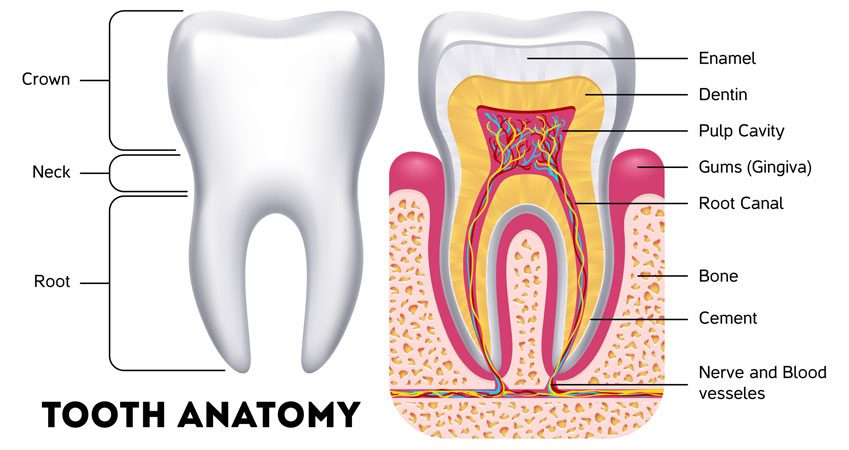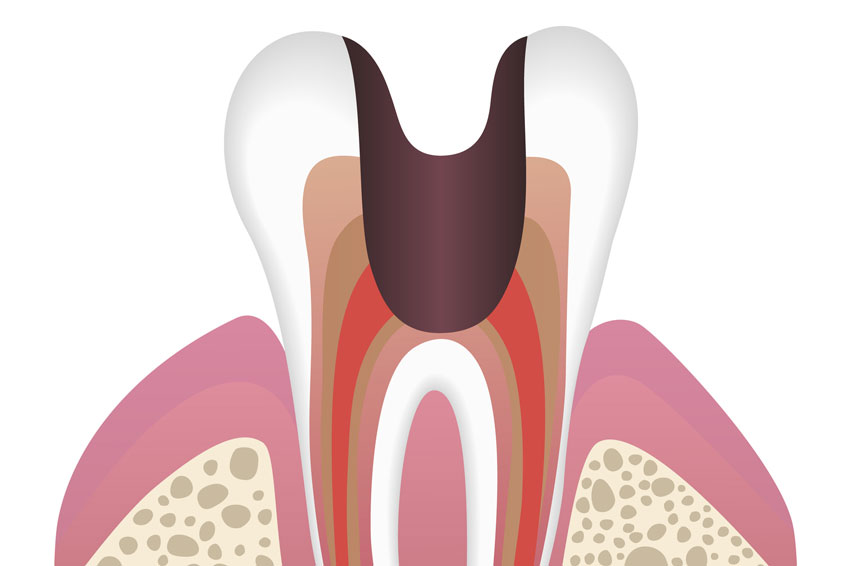No one enjoys having dental caries, also known as cavities.
You might not realize that tooth decay occurs in stages, and that the specific stage of tooth decay will affect its treatment. Early tooth decay is easier to treat than later stages where infection can spread into your jaw. Let’s take a closer look at each stage of dental caries.

 Stage One: Loss of Mineralization
Stage One: Loss of Mineralization
The enamel that covers your teeth is composed of minerals, mainly calcium. The first step that leads to dental caries is the loss of minerals from tooth enamel. Plaque that builds up on your teeth contains bacteria, and these bacteria produce acids that hasten mineral loss. You might not see anything abnormal when you look at your teeth at this stage of decay, but it is set for further decay, and there may be a white spot where the enamel has eroded.
 Stage Two: Enamel Breakdown
Stage Two: Enamel Breakdown
If a tooth continues to lose minerals, it weakens the enamel to the point where you might notice a dark spot where the white spot once was. At this stage, dental caries requires treatment to prevent further progression.
When you visit a us, we drill the brown spot where the enamel has broken down and fill it with a substance that will prevent further destruction of the tooth.
 Stage Three: Involvement of the Dentin
Stage Three: Involvement of the Dentin
Underneath the enamel of your teeth is a softer tissue called dentin. The dentin of your teeth contains tiny canals that carry temperature information from the outside environment to the nerves that supply your teeth.
If the dentin is exposed to the outside from enamel breakdown, your tooth may become more sensitive to temperature. When you bite into something hot or cold or drink a cold or hot beverage, you may experience pain. Temperature sensitivity is often the first sign of a deeper cavity (OOF!).
 Stage Four: Damage to the Pulp
Stage Four: Damage to the Pulp
Beneath the dentin is another tissue layer called the pulp. This is the region of the tooth that contains the blood vessels. If the infection reaches the pulp, inflammation causes the pulp to swell, leading to pain.
With pulp damage, you may experience constant tooth pain. In the early stages, infection of the pulp, called pulpitis, causes only brief pain and temperature sensitivity when you eat something hot or cold. As it progresses and moves deeper into the pulp, the pain becomes constant.
If pulpitis is caught in the early stages, it may be reversible without root canal therapy, but if the pain is persistent, you’ll need a root canal. Temperature sensitivity that lasts more than 5 seconds may be a sign of irreversible pulpitis.
 Stage Five: Abscess
Stage Five: Abscess
The final stage of dental caries is an abscess. If you don’t treat dental caries at the pulp damage stage, decay can enter the pulp. At this point, the pulp becomes more inflamed, and pus forms within a closed space, creating a painful abscess. An abscessed tooth is one of the most painful conditions you can experience. It can also be dangerous. Without treatment, infection and inflammation can spread into the jaw or into structures in the head or neck.
At this stage, the only effective treatment is a root canal or tooth extraction. We would first prescribe antibiotics to reduce infection and swelling before treating the infected tooth. It’s essential to treat an abscessed tooth as early as possible to avoid the spread of the infection.
The Bottom Line

You can lower your risk of dental caries by brushing and flossing twice a day and using toothpaste with fluoride. Consult us regularly for deep cleaning to remove tartar. You can’t remove tartar at home with brushing or flossing. Beyond dental caries, tartar inflames the gum line and allows the entry of bacteria that cause gum disease.
You can reduce plaque build-up with twice-daily brushing and flossing, but even with the most skilled brushing, some tartar will form. Our practitioners can best remove it and lower your risk of dental caries and gum disease. Taking care of your teeth is a smart investment!
References:
Abou Neel EA, Aljabo A, Strange A, Ibrahim S, Coathup M, Young AM, Bozec L, Mudera V. Demineralization-remineralization dynamics in teeth and bone. Int J Nanomedicine. 2016 Sep 19;11:4743-4763. doi: 10.2147/IJN.S107624. PMID: 27695330; PMCID: PMC5034904.
“Cavities/tooth decay – Symptoms and causes – Mayo Clinic.” 19 Jul. 2017, mayoclinic.org/diseases-conditions/cavities/symptoms-causes/syc-20352892.


















